Night-to-Day Image Translation with Road Light Attention Training for Traffic Information Detection
Abstract
1. Introduction
- A dual-module framework integrating an unpaired training module for global, stylistic conversion and a four-channel paired module for preserving fine details.
- An inverse road light attention (RLA) map utilized as a fourth input channel to explicitly guide the network in preserving critical luminous features like traffic lights.
- An RLA-map-based cross-blending technique to seamlessly fuse the outputs, combining natural backgrounds from the unpaired module with the detailed foregrounds from the paired module.
2. Related Work
2.1. Low-Light Surrounding Image Enhancement
2.2. Image-to-Image Translation
3. Proposed Method
3.1. Overview of the Proposed Method
3.2. Night-to-Day Image Conversion Training Process
| Algorithm 1 Unpaired Training Module |
| Require: Unpaired input images: 1: Let be the output of the unpaired training module 2: = UnpairedTrainingModule() 3: Compute the linear light map follows: 4: 5: where and denotes the mean intensity of the image 6: Compute the final using the linear light map: 7: 8: Return |
| Algorithm 2 Inverse Road Light Attention (RLA) Map Generation |
| Require: Input: 1: Convert the RGB images to the LAB color space: 2: Extract the L-channel: 3: Apply the bilateral filter: BilateralFilter() 4: Compute the exponential light map: 5. Generate the RLA map: 6: Invert the attention map: 7: Return |
3.3. Image Area Selection and Blending
| Algorithm 3 Image Area Selection and Cross-Blending Process |
| Require: 1. Definition: denotes the generator trained in the unpaired module 2. Definition: denotes the generator trained in the four-channel paired module 3. Unpaired translation: 4. Paired translation: 5: Weight-unpaired result: 6: Weight-paired result: 7: Cross-blending: 8: Return |
4. Experiments and Results
4.1. Simulation Settings
4.2. Ablation Experiments
- Case 1: Employs Denoising Diffusion Probabilistic Models (DDPMs) to serve as a comparative benchmark against our CycleGAN-based approach.
- Case 2: Serves as the baseline, consisting of our paired module with a standard three-channel (RGB) input.
- Case 3: Adds the inverse RLA map as a fourth input channel to Case 2 to assess the map’s contribution.
- Case 4: Represents the full model, which blends the paired and unpaired modules, but uses a suboptimal blending parameter (γ = 0.5) to validate our choice of γ.
- Case 5: Our final model, which combines the four-channel paired module with the unpaired module using the optimal parameter (γ = 2).
4.3. Comparative Experiments
4.4. Quantitative Evaluations
5. Discussion
6. Conclusions
Author Contributions
Funding
Data Availability Statement
Conflicts of Interest
References
- Goodfellow, I.; Pouget-Abadie, J.; Mirza, M.; Xu, B.; Warde-Farley, D.; Ozair, S.; Courville, A.; Bengio, Y. Generative Adversarial Networks. Sci. Robot. 2014, 3, 2672–2680. [Google Scholar] [CrossRef]
- Mirza, M.; Osindero, S. Conditional Generative Adversarial Nets. arXiv 2014, arXiv:1411.1784. [Google Scholar] [CrossRef]
- Tahmid, M.; Alam, M.S.; Rao, N.; Ashrafi, K.M.A. Image-to-Image Translation with Conditional Adversarial Networks. In Proceedings of the 2023 IEEE 9th International Women in Engineering (WIE) Conference on Electrical and Computer Engineering, WIECON-ECE 2016, Thiruvananthapuram, India, 25–26 November 2023; pp. 468–472. [Google Scholar] [CrossRef]
- Zhu, J.Y.; Park, T.; Isola, P.; Efros, A.A. Unpaired Image-to-Image Translation using Cycle-Consistent Adversarial Networks. In Proceedings of the IEEE International Conference on Computer Vision, Venice, Italy, 22–29 October 2017; pp. 2242–2251. [Google Scholar] [CrossRef]
- Qin, M.; Fan, Y.; Guo, H.; Wang, M. Application of Improved CycleGAN in Laser-Visible Face Image Translation. Sensors 2022, 22, 4057. [Google Scholar] [CrossRef] [PubMed]
- Arruda, V.F.; Paixão, T.M.; Berriel, R.F.; De Souza, A.F.; Badue, C.; Sebe, N. Cross-Domain Car Detection Using Unsupervised Image-to-Image Translation: From Day to Night. In Proceedings of the International Joint Conference on Neural Networks, Budapest, Hungary, 14–19 July 2019. [Google Scholar] [CrossRef]
- Decuyper, M.; Stockhoff, M.; Vandenberghe, S.; Ying, X. An Overview of Overfitting and its Solutions. J. Phys. Conf. Ser. 2019, 1168, 022022. [Google Scholar] [CrossRef]
- Nayar, S.K.; Mitsunaga, T. High dynamic range imaging: Spatially varying pixel exposures. In Proceedings of the IEEE Computer Society Conference on Computer Vision and Pattern Recognition, Hilton Head, SC, USA, 15 June 2000; Volume 1, pp. 472–479. [Google Scholar] [CrossRef]
- Parihar, S.; Singh, K. A study on Retinex based method for image enhancement. In Proceedings of the 2nd International Conference on Inventive Systems and Control, ICISC 2018, Coimbatore, India, 19–20 January 2018; pp. 619–624. [Google Scholar] [CrossRef]
- Liu, S.; Zhang, X.; Sun, L.; Liang, Z.; Zeng, H.; Zhang, L. Joint HDR Denoising and Fusion: A Real-World Mobile HDR Image Dataset. In Proceedings of the 2023 IEEE/CVF Conference on Computer Vision and Pattern Recognition (CVPR), Vancouver, BC, Canada, 17–24 June 2023; pp. 13966–13975. [Google Scholar] [CrossRef]
- Reinhard, E. Parameter Estimation for Photographic Tone Reproduction. J. Graph. Tools 2002, 7, 45–51. [Google Scholar] [CrossRef]
- Farbman, Z.; Fattal, R.; Lischinski, D.; Szeliski, R. Edge-preserving decompositions for multi-scale tone and detail manipulation. ACM Trans. Graph. 2008, 27, 1–10. [Google Scholar] [CrossRef]
- Khan, R.; Rahardja, S.; Khan, M.M.; Movania, M.M.; Abed, F. A Tone-Mapping Technique Based on Histogram Using a Sensitivity Model of the Human Visual System. IEEE Trans. Ind. Electron. 2018, 65, 3469–3479. [Google Scholar] [CrossRef]
- Gonzalez, R.C.; Woods, R.E. Digital Image Processing, 3rd ed.; Pearson Prentice Hall: Upper Saddle River, NJ, USA, 2008. [Google Scholar]
- Zuiderveld, K. Contrast limited adaptive histogram equalization. In Graphics Gems; Academic Press: San Diego, CA, USA, 1994; pp. 474–485. [Google Scholar] [CrossRef]
- Hoyez, H.; Schockaert, C.; Rambach, J.; Mirbach, B.; Stricker, D. Unsupervised Image-to-Image Translation: A Review. Sensors 2022, 22, 8540. [Google Scholar] [CrossRef] [PubMed]
- Kim, T.; Cha, M.; Kim, H.; Lee, J.K.; Kim, J. Learning to Discover Cross-Domain Relations with Generative Adversarial Networks. In Proceedings of the 34th International Conference on Machine Learning, ICML, Sydney, NSW, Australia, 6–11 August 2017; Volume 4, pp. 2941–2949. [Google Scholar]
- Minaee, S.; Boykov, Y.; Porikli, F.; Plaza, A.; Kehtarnavaz, N.; Terzopoulos, D. Image Segmentation Using Deep Learning: A Survey. IEEE Trans. Pattern Anal. Mach. Intell. 2020, 44, 3523–3542. [Google Scholar] [CrossRef] [PubMed]
- Oussidi and Elhassouny, A. Deep generative models: Survey. In Proceedings of the 2018 International Conference on Intelligent Systems and Computer Vision, ISCV 2018, Fez, Morocco, 2–4 April 2018. [Google Scholar] [CrossRef]
- Kingma, D.P.; Welling, M. Auto-Encoding Variational Bayes. In Proceedings of the 2nd International Conference on Learning Representations, ICLR 2014—Conference Track Proceedings, Banff, AB, Canada, 14–16 April 2014. [Google Scholar] [CrossRef]
- Rezende, D.J.; Mohamed, S.; Wierstra, D. Stochastic Backpropagation and Approximate Inference in Deep Generative Models. In Proceedings of the 31st International Conference on Machine Learning, ICML 2014, Beijing, China, 21–26 June 2014; Volume 4, pp. 3057–3070. [Google Scholar]
- Mak, H.W.L.; Han, R.; Yin, H.H.F. Application of Variational AutoEncoder (VAE) Model and Image Processing Approaches in Game Design. Sensors 2023, 23, 3457. [Google Scholar] [CrossRef] [PubMed]
- Srivastava, A.; Valkov, L.; Russell, C.; Gutmann, M.U.; Sutton, C. VEEGAN: Reducing Mode Collapse in GANs using Implicit Variational Learning. In Proceedings of the 31st International Conference on Neural Information Processing Systems, Long Beach, CA, USA, 4–9 December 2017; pp. 3309–3319. [Google Scholar]
- Anoosheh, A.; Sattler, T.; Timofte, R.; Pollefeys, M.; Van Gool, L. Night-to-Day Image Translation for Retrieval-based Localization. In Proceedings of the 2019 International Conference on Robotics and Automation (ICRA), Montreal, QC, Canada, 20–24 May 2019; pp. 5958–5964. [Google Scholar] [CrossRef]
- Anoosheh, A.; Agustsson, E.; Timofte, R.; Van Gool, L. ComboGAN: Unrestrained Scalability for Image Domain Translation. In Proceedings of the 2018 IEEE/CVF Conference on Computer Vision and Pattern Recognition Workshops (CVPRW), Salt Lake City, UT, USA, 18–22 June 2018; pp. 896–903. [Google Scholar] [CrossRef]
- Zhang, H.; Goodfellow, I.; Metaxas, D.; Odena, A. Self-Attention Generative Adversarial Networks. CEUR Workshop Proc. 2018, 3885, 69–78. Available online: https://arxiv.org/pdf/1805.08318 (accessed on 4 September 2025).
- Wang, W.; Yin, B.; Li, L.; Li, L.; Liu, H. A Low Light Image Enhancement Method Based on Dehazing Physical Model. Comput. Model. Eng. Sci. 2025, 143, 1595–1616. [Google Scholar] [CrossRef]
- Ragavendirane, M.S.; Dhanasekar, S. Low-Light Image Enhancement via New Intuitionistic Fuzzy Generator-Based Retinex Approach. IEEE Access 2025, 13, 38454–38469. [Google Scholar] [CrossRef]
- Ho, Q.T.; Duong, M.T.; Lee, S.; Hong, M.C. Adaptive Image Deblurring Convolutional Neural Network with Meta-Tuning. Sensors 2025, 25, 5211. [Google Scholar] [CrossRef] [PubMed]
- Saharia, C.; Chan, W.; Chang, H.; Lee, C.; Ho, J.; Salimans, T.; Fleet, D.; Norouzi, M. Palette: Image-to-Image Diffusion Models. In Proceedings of the SIGGRAPH ’22: ACM SIGGRAPH 2022 Conference, Vancouver, BC, Canada, 7–11 August 2022; pp. 1–10. [Google Scholar] [CrossRef]
- Son, M.; Kwon, H.J.; Lee, S.H. Enhanced Night-to-Day Image Conversion Using CycleGAN-Based Base-Detail Paired Training. Mathematics 2023, 11, 3102. [Google Scholar] [CrossRef]
- Venkatanath, N.; Praneeth, D.; Chandrasekhar Bh, M.; Channappayya, S.S.; Medasani, S.S. Blind image quality evaluation using perception based features. In Proceedings of the 2015 Twenty First National Conference on Communications (NCC), Mumbai, India, 27 February–1 March 2015. [Google Scholar] [CrossRef]
- Narvekar, N.D.; Karam, L.J. A No-Reference Image Blur Metric Based on the Cumulative Probability of Blur Detection (CPBD). IEEE Trans. Image Process. 2011, 20, 2678–2683. [Google Scholar] [CrossRef] [PubMed]
- Sazzad, Z.M.P.; Kawayoke, Y.; Horita, Y. No reference image quality assessment for JPEG2000 based on spatial features. Signal Process. Image Commun. 2008, 23, 257–268. [Google Scholar] [CrossRef]
- Vu, T.; Chandler, D.M. S3: A Spectral and Spatial Sharpness Measure. In Proceedings of the 2009 First International Conference on Advances in Multimedia, Colmar, France, 20–25 July 2009. [Google Scholar] [CrossRef]
- Kang, L.; Ye, P.; Li, Y.; Doermann, D. Convolutional Neural Networks for No-Reference Image Quality Assessment. In Proceedings of the 2014 IEEE Conference on Computer Vision and Pattern Recognition, Columbus, OH, USA, 23–28 June 2014. [Google Scholar] [CrossRef]
- Yang, S.; Wu, T.; Shi, S.; Lao, S.; Gong, Y.; Cao, M.; Wang, J.; Yang, Y. MANIQA: Multi-Dimension Attention Network for No-Reference Image Quality Assessment. Available online: https://github.com/IIGROUP/MANIQA (accessed on 15 July 2025).
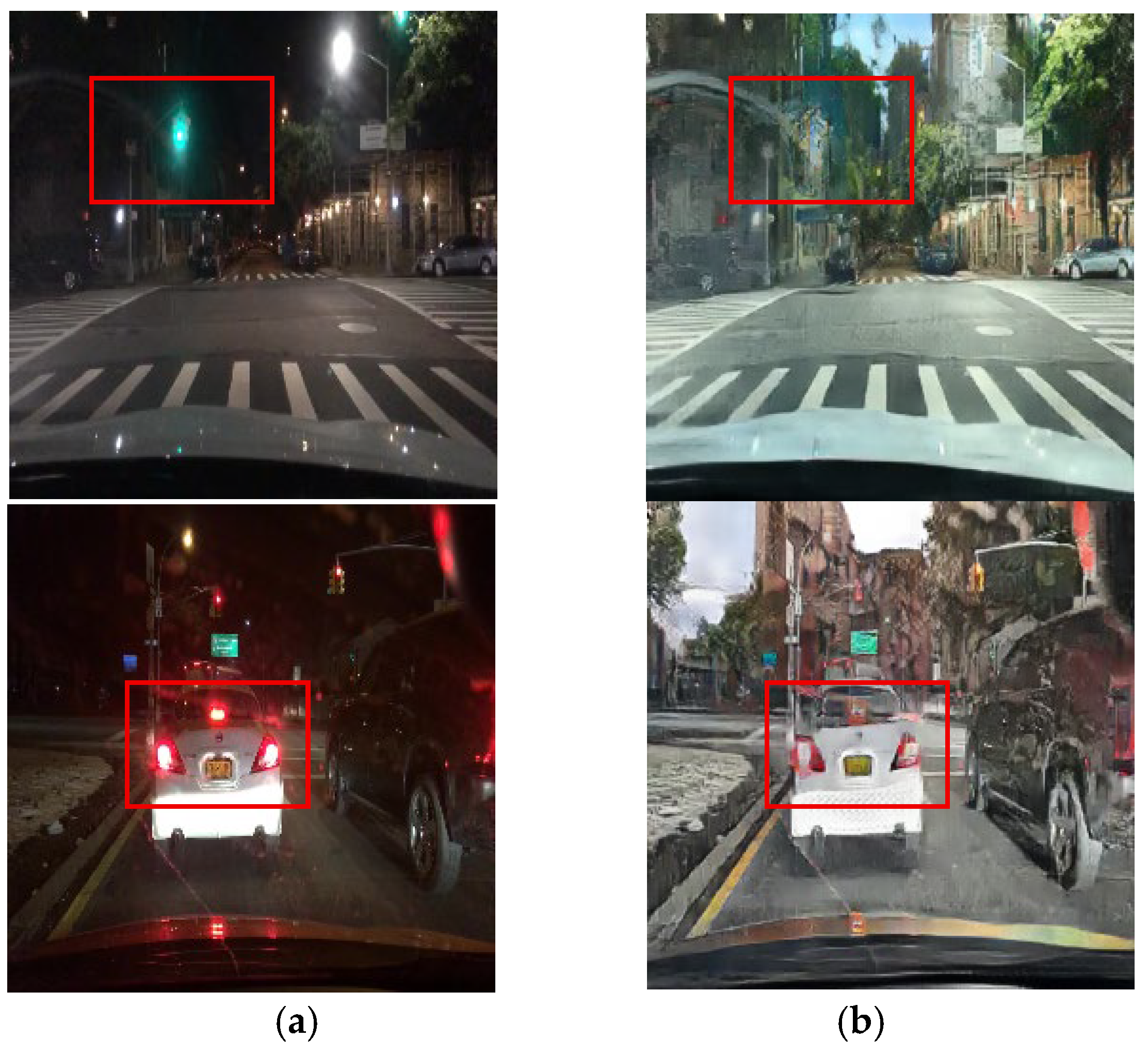
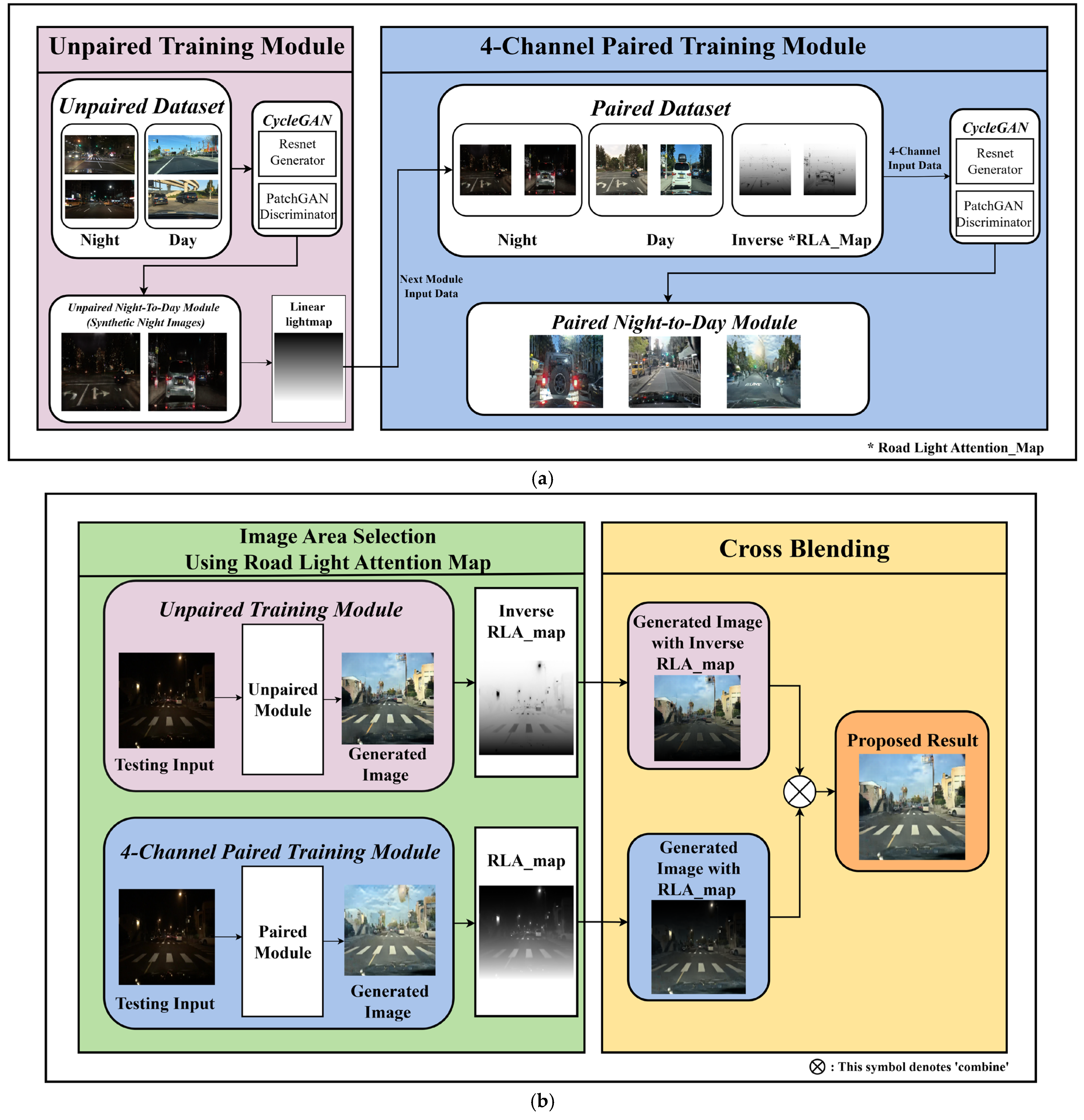
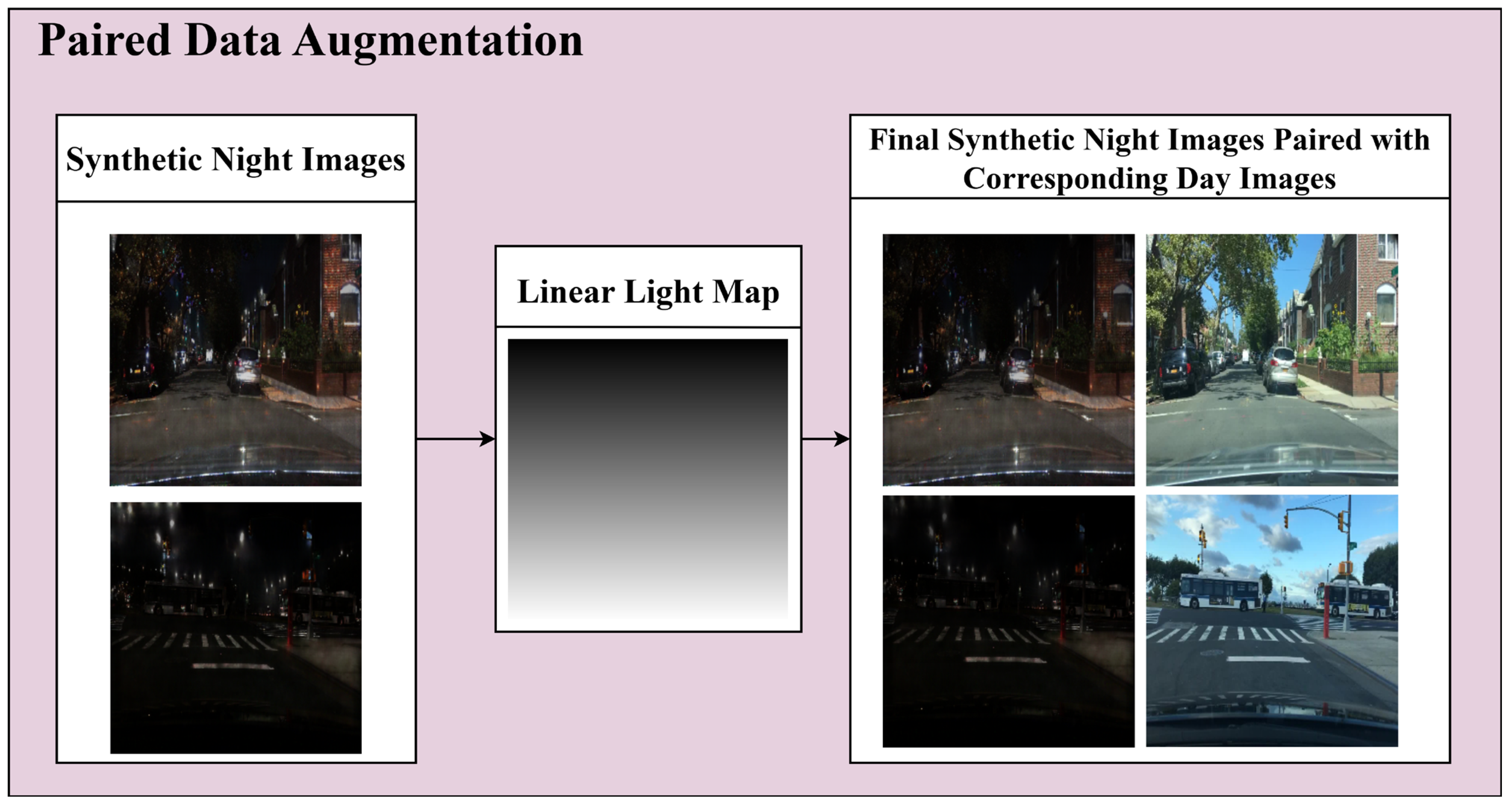

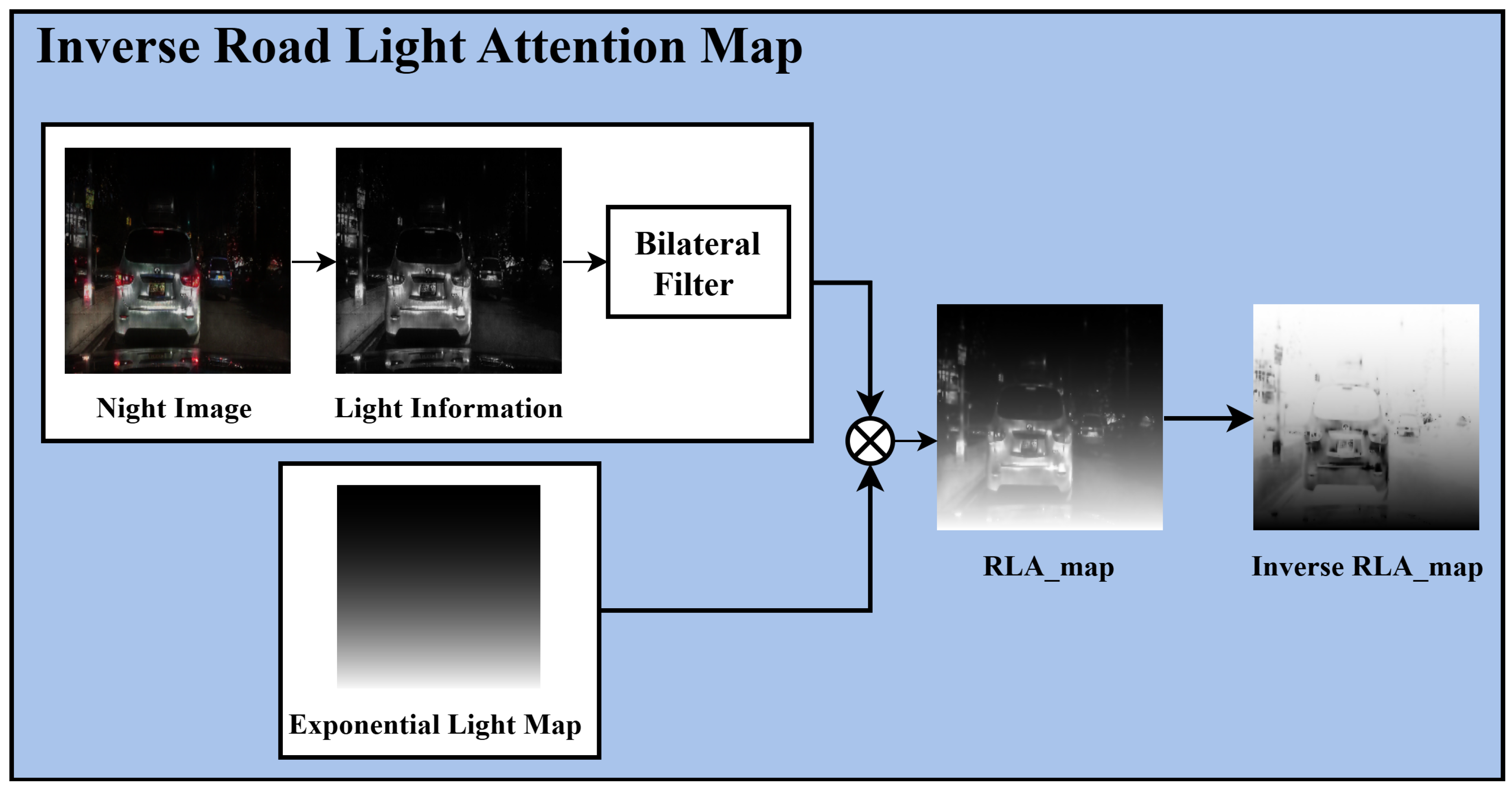
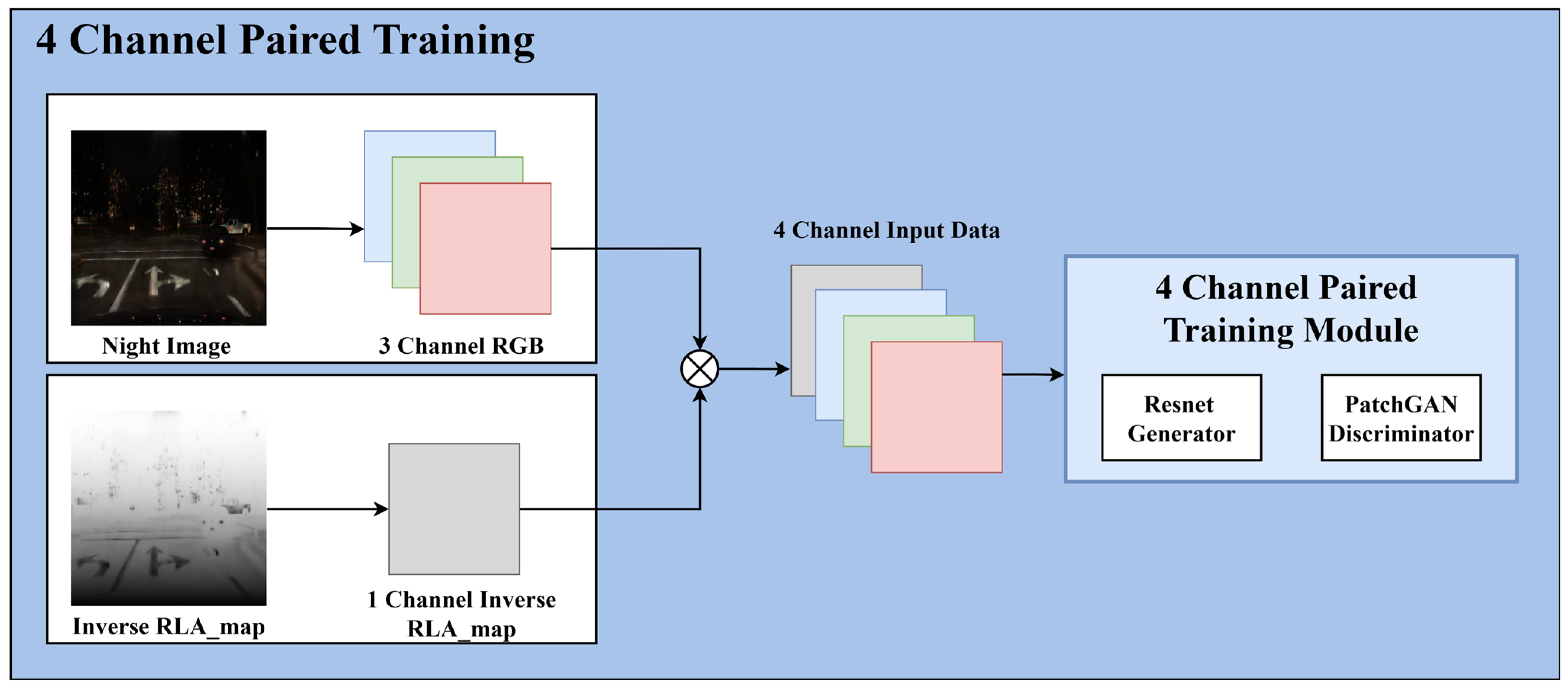


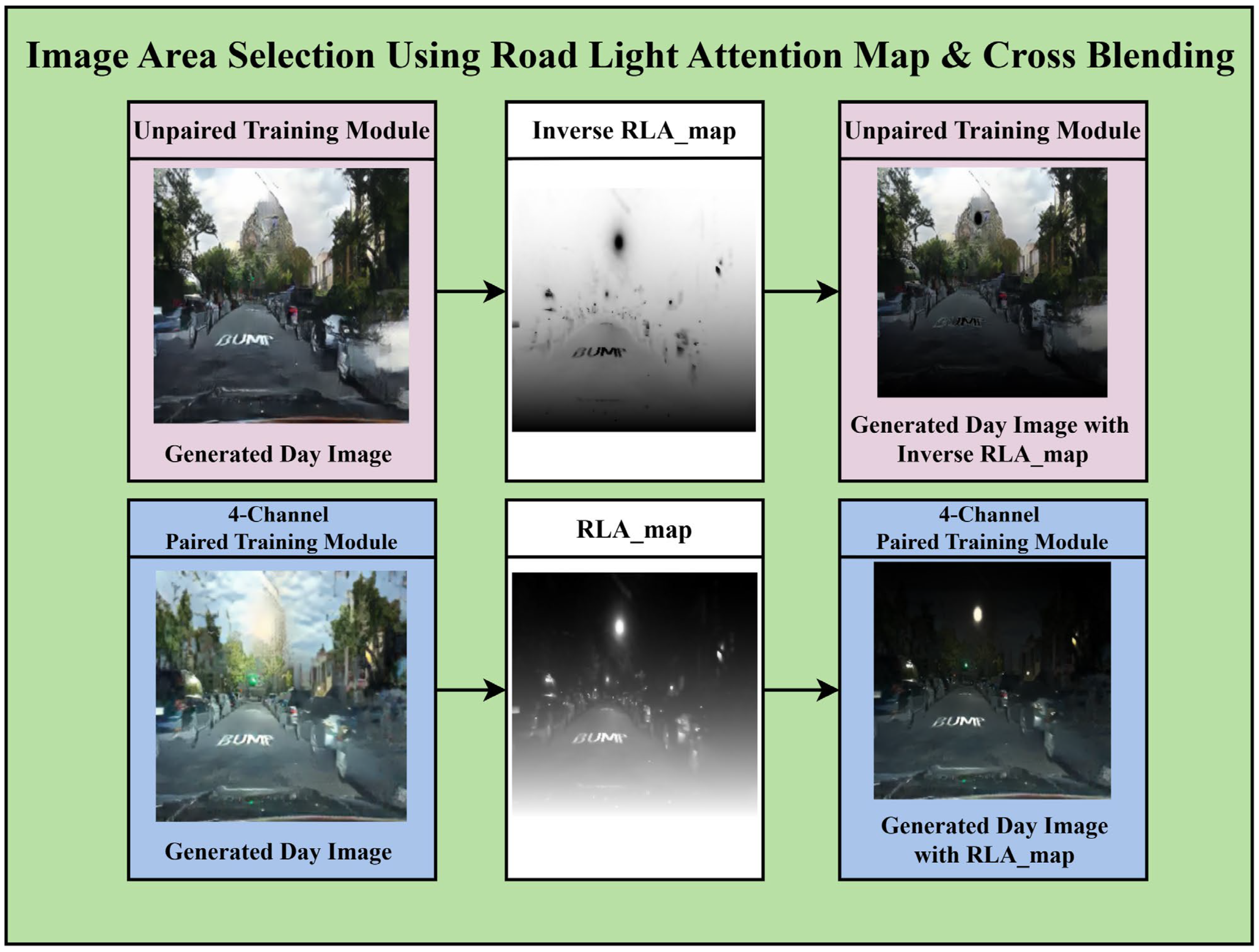
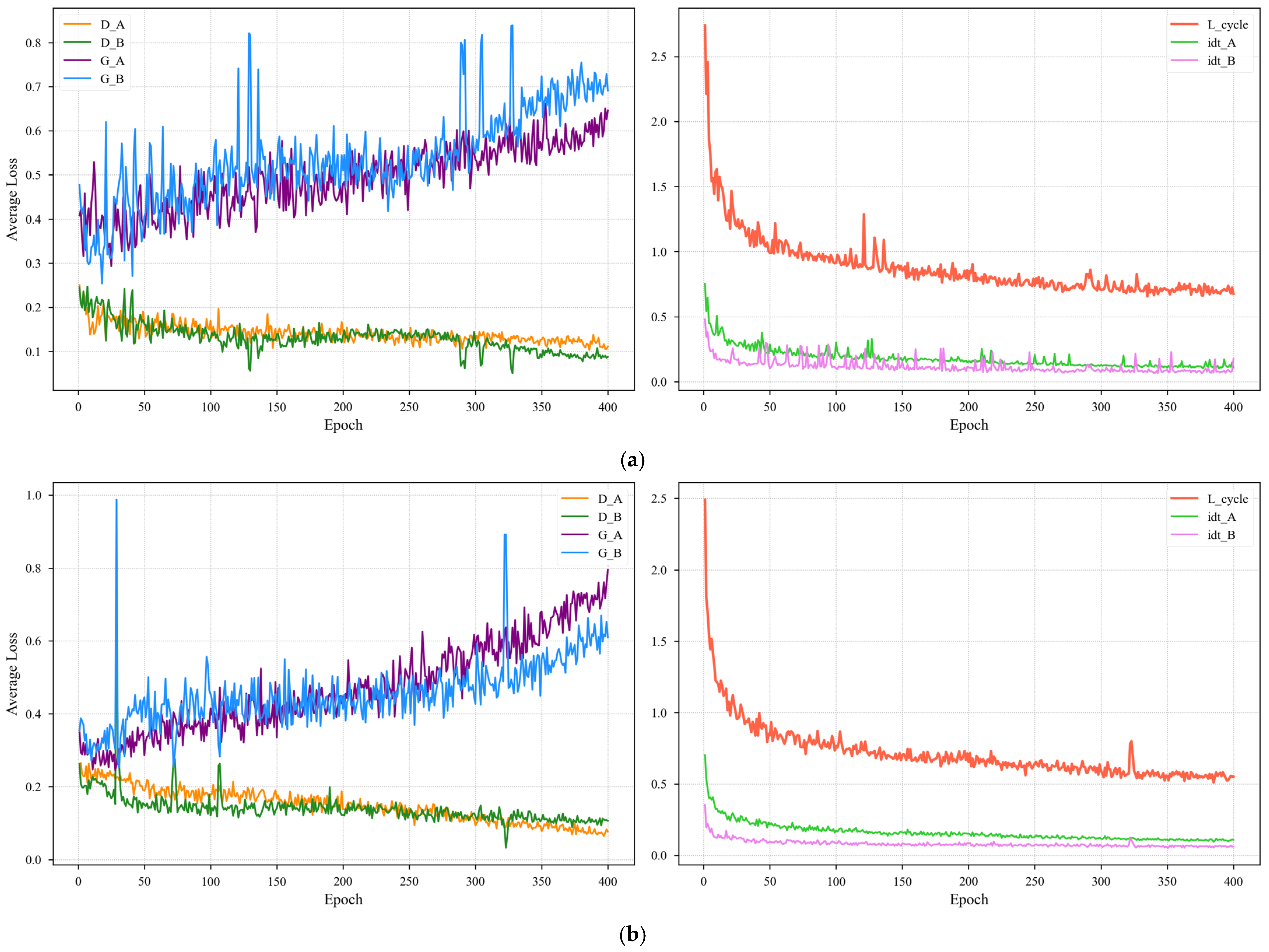




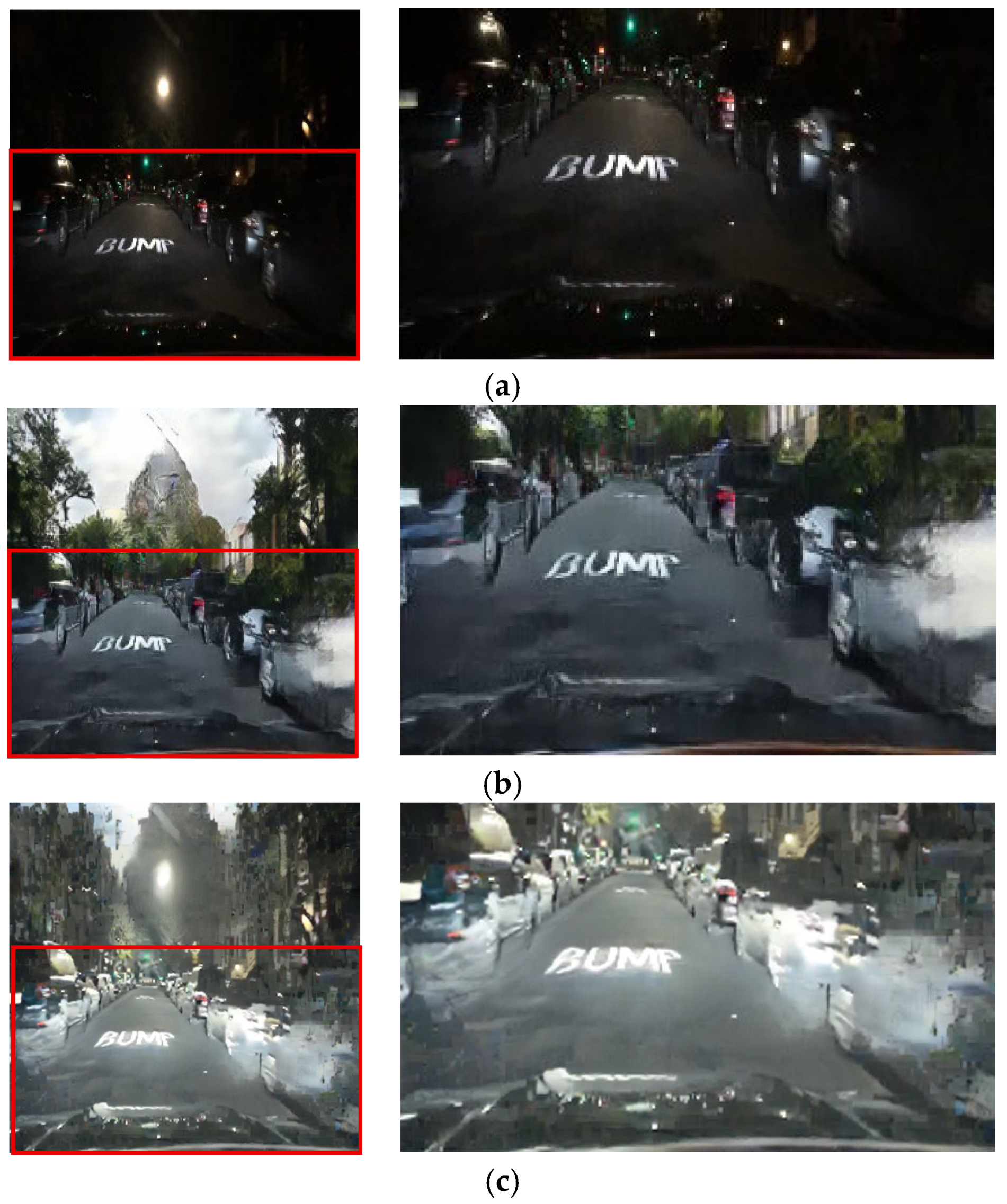
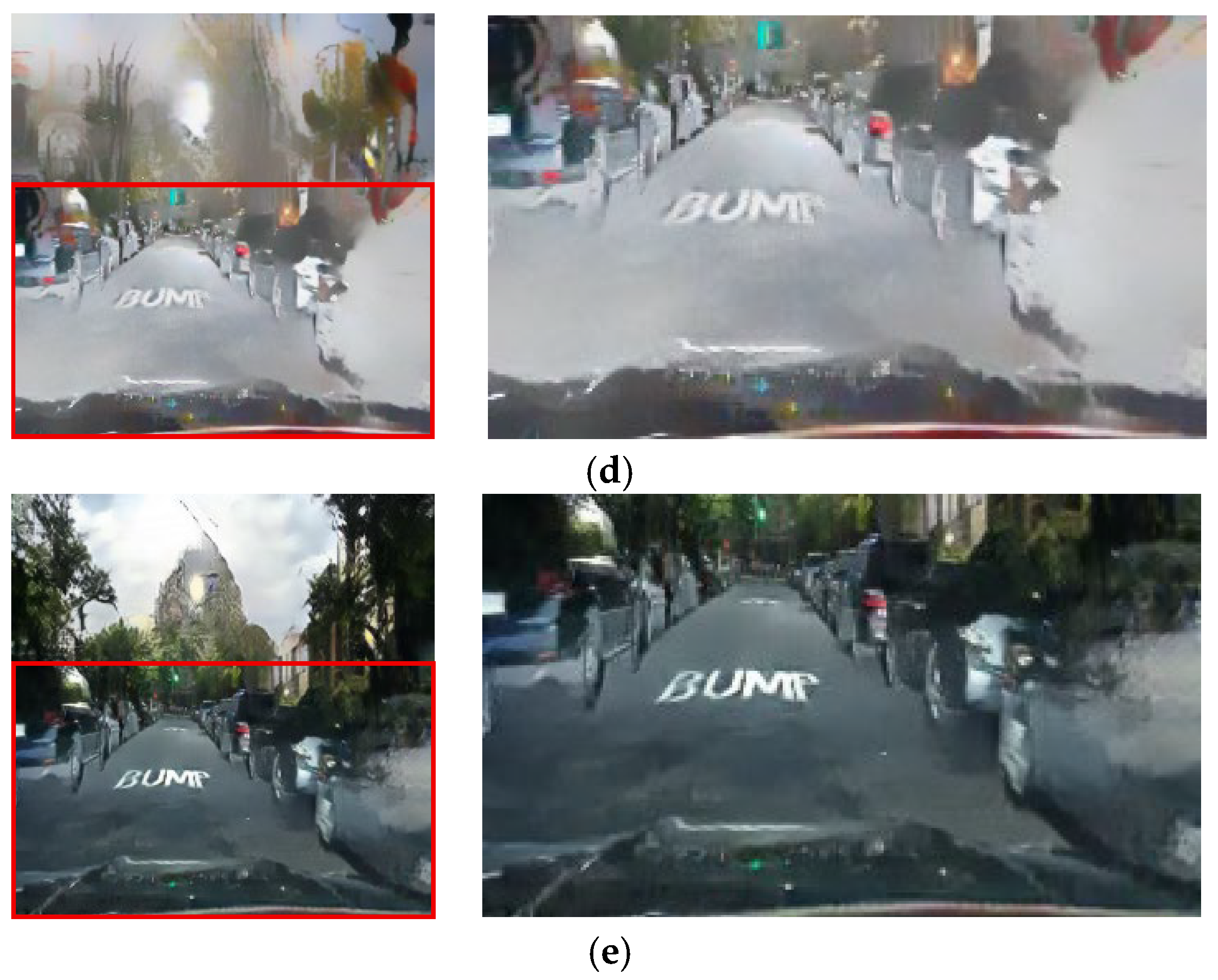
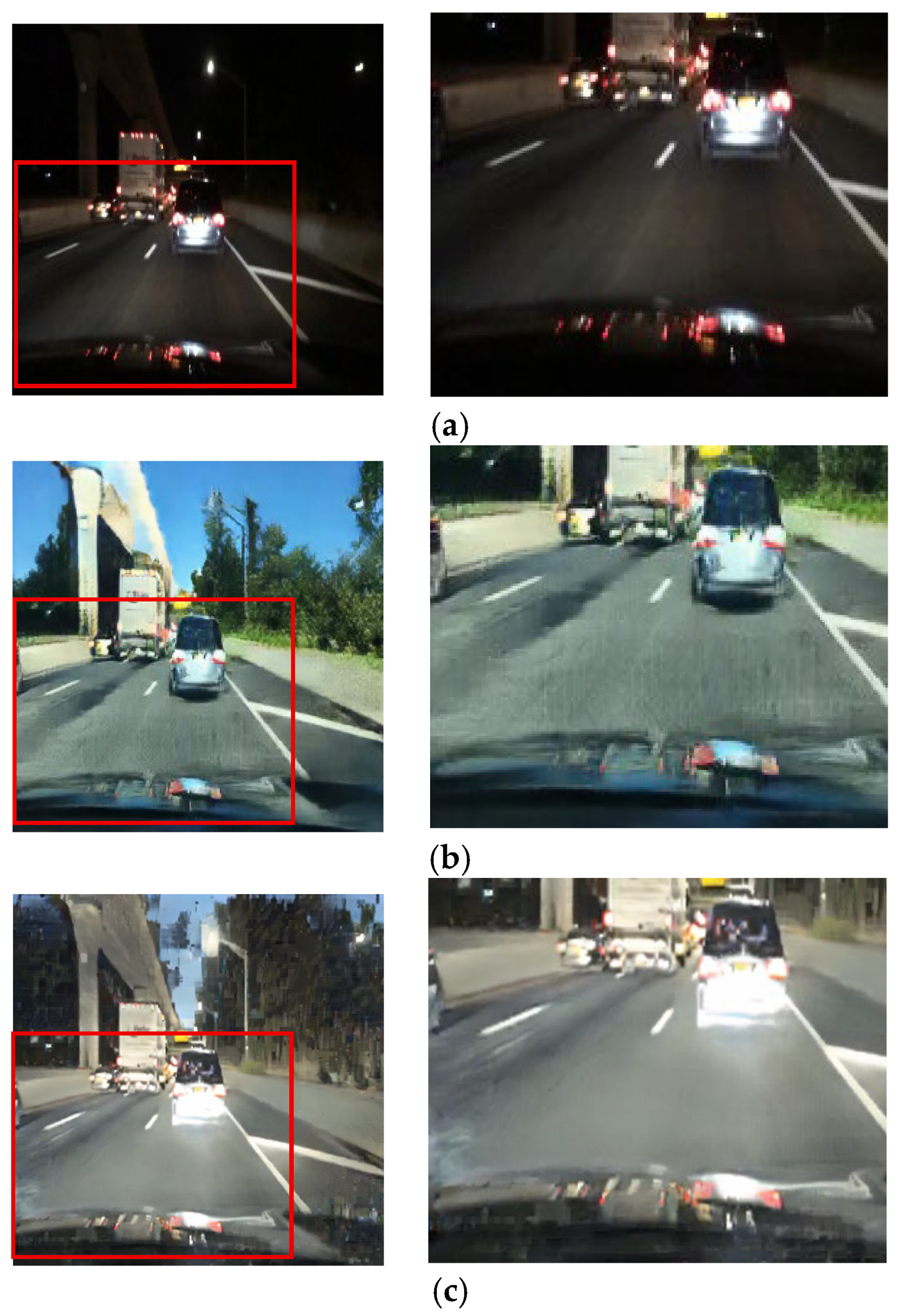
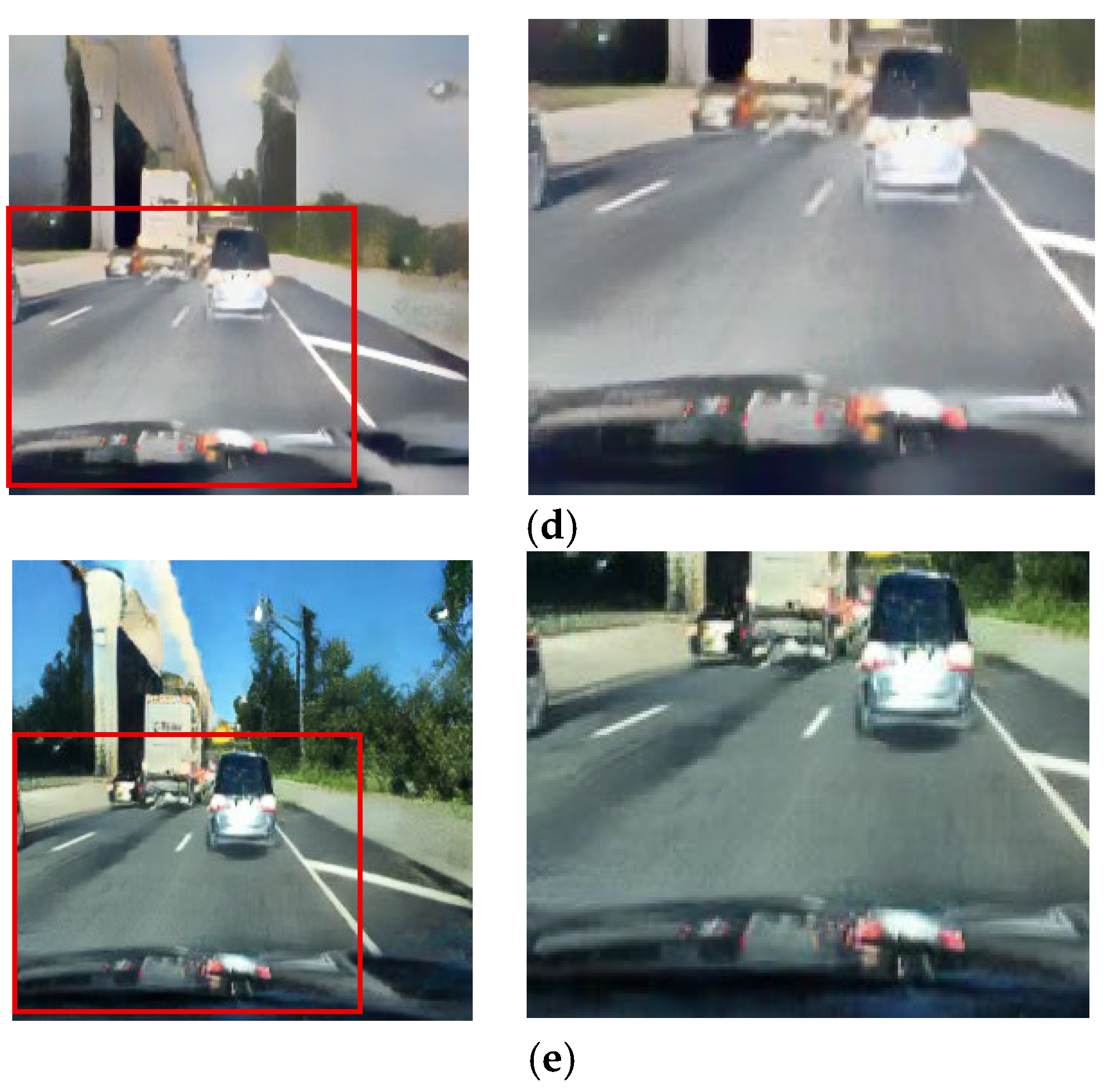
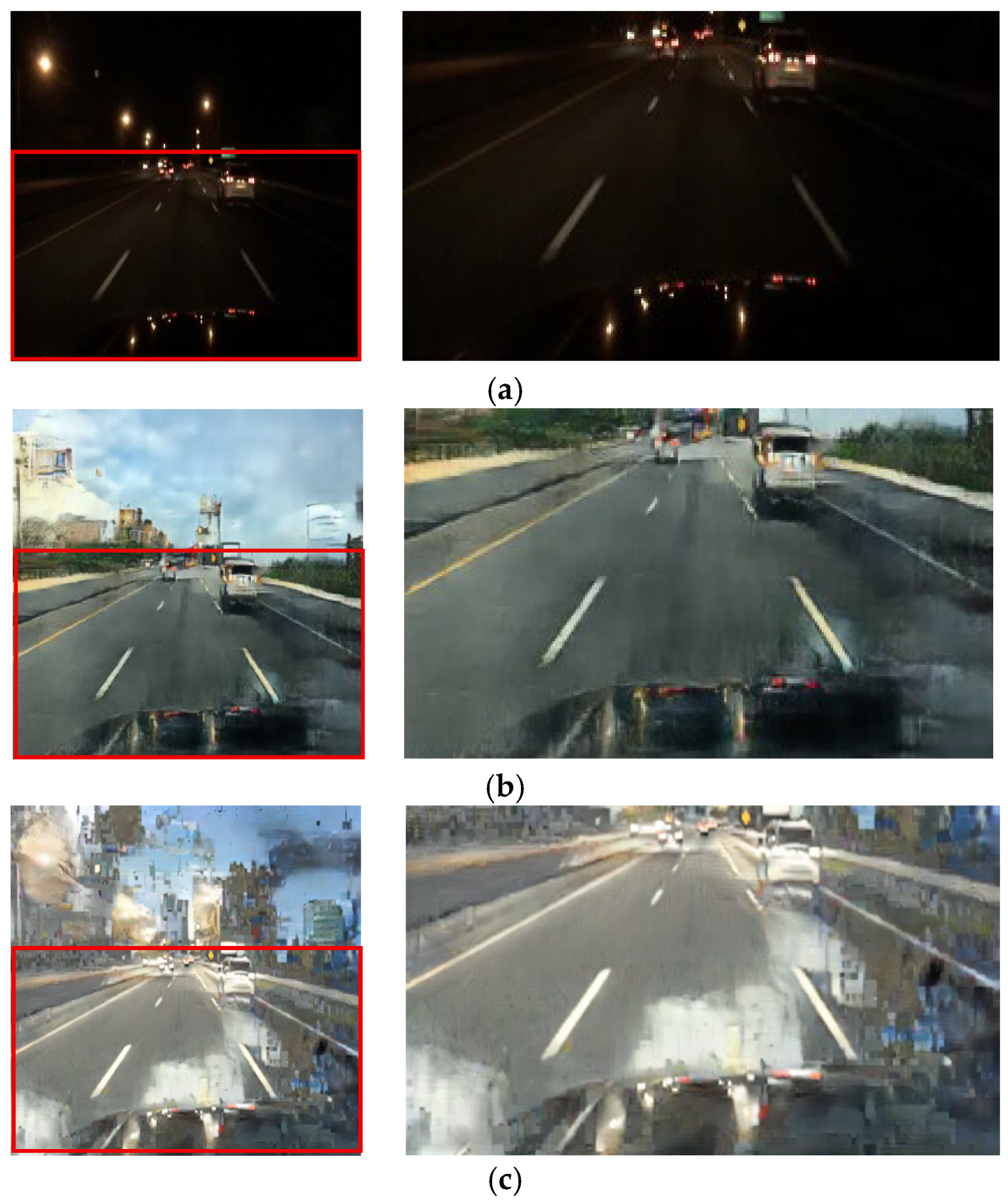
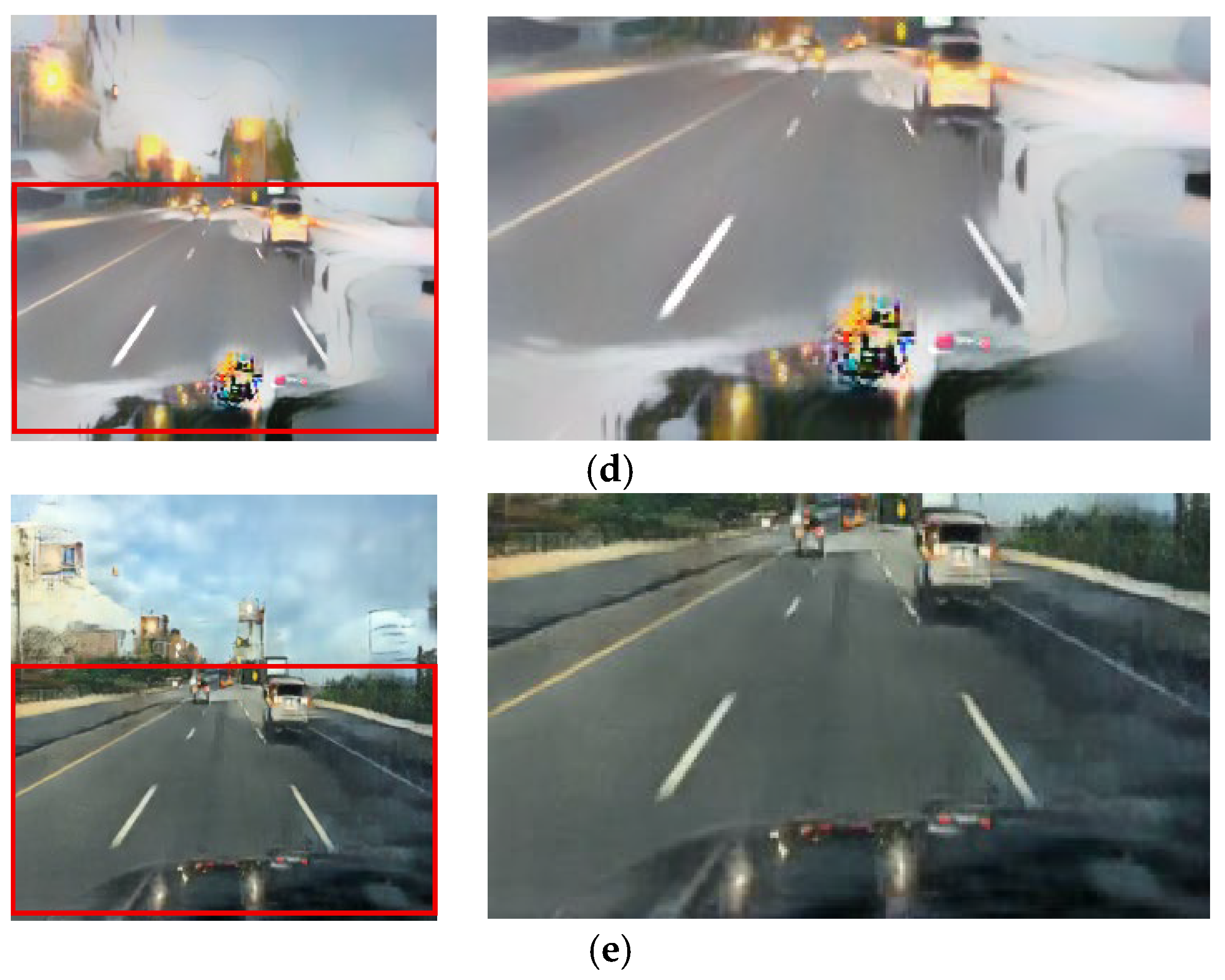
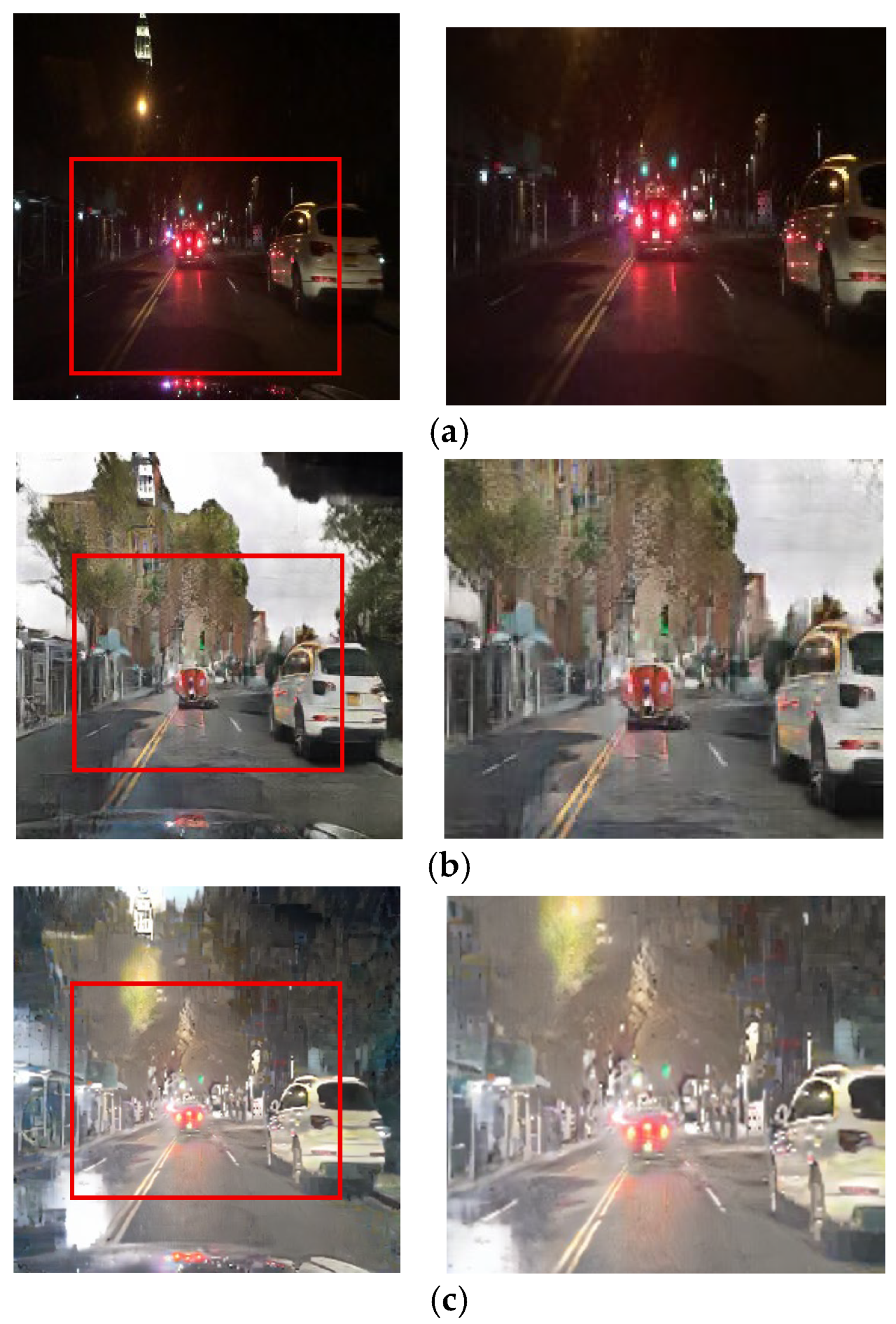


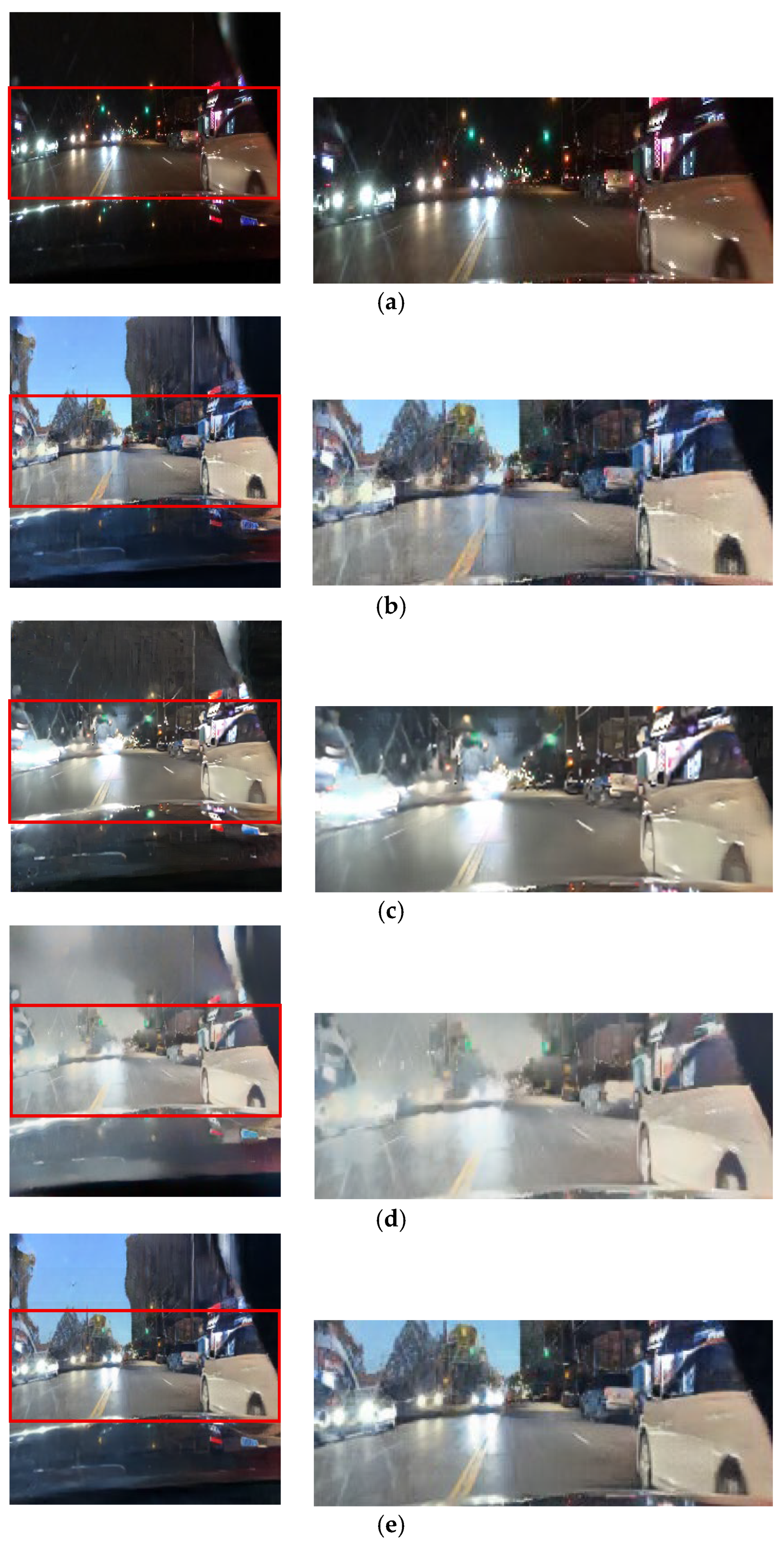
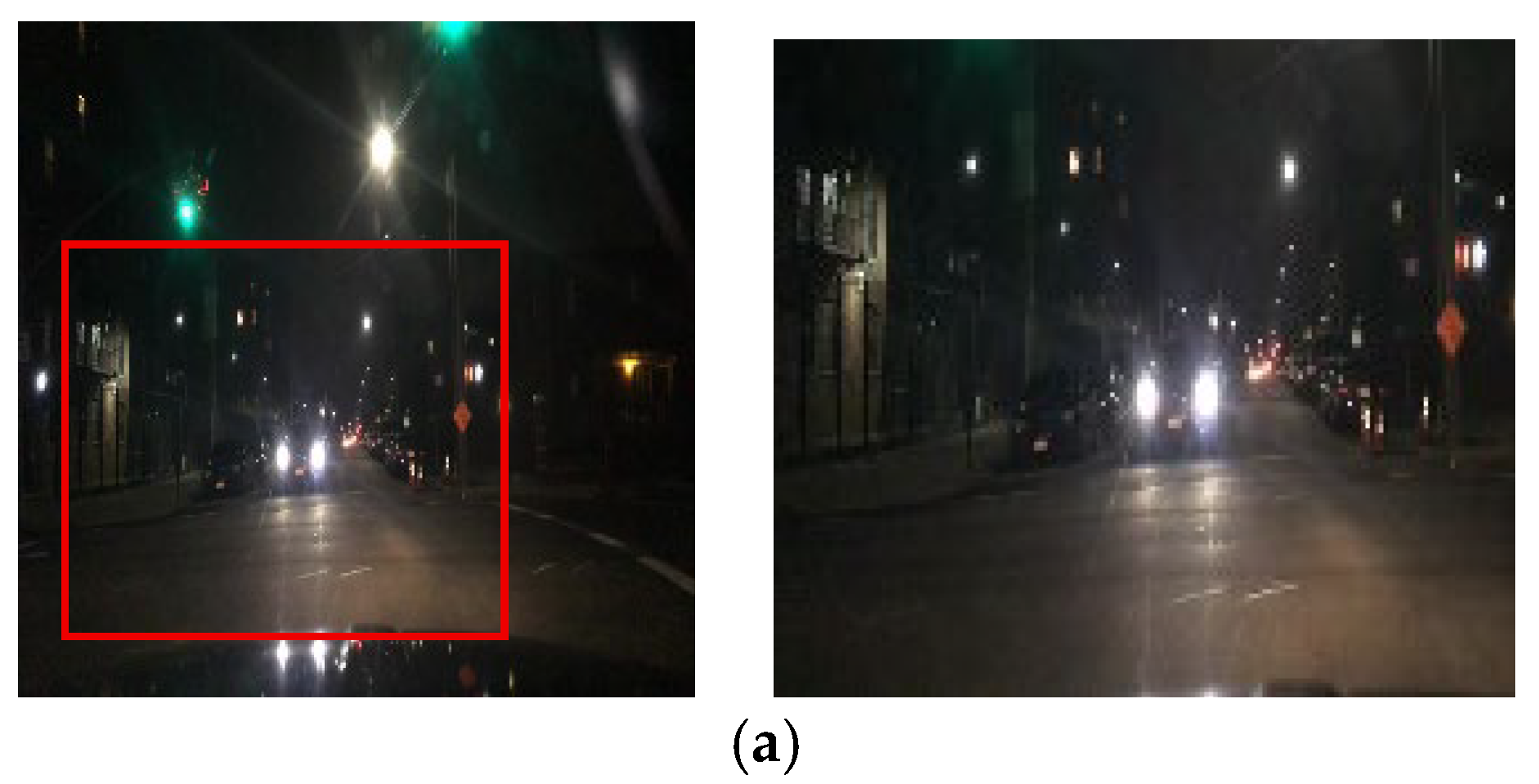
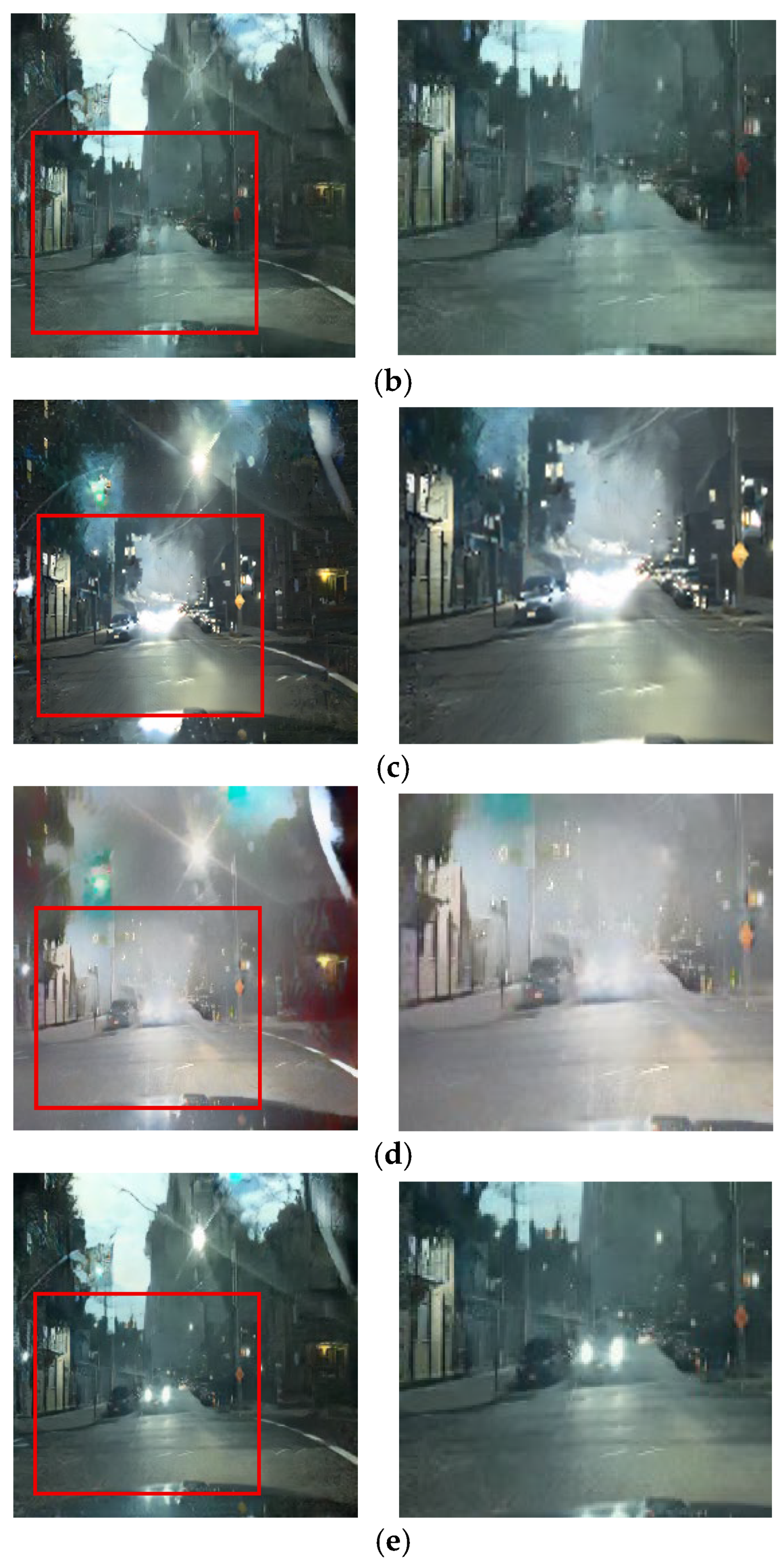
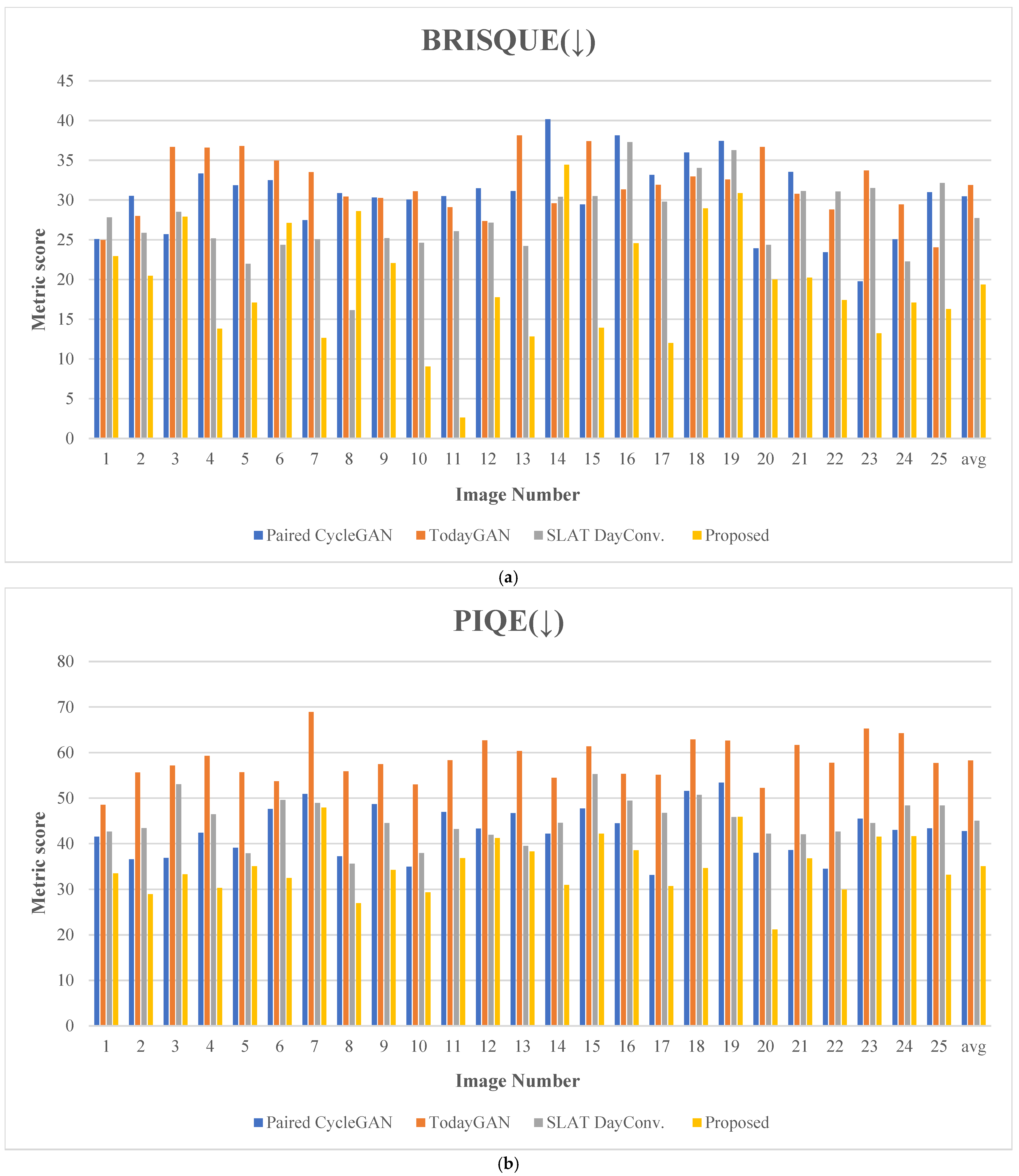
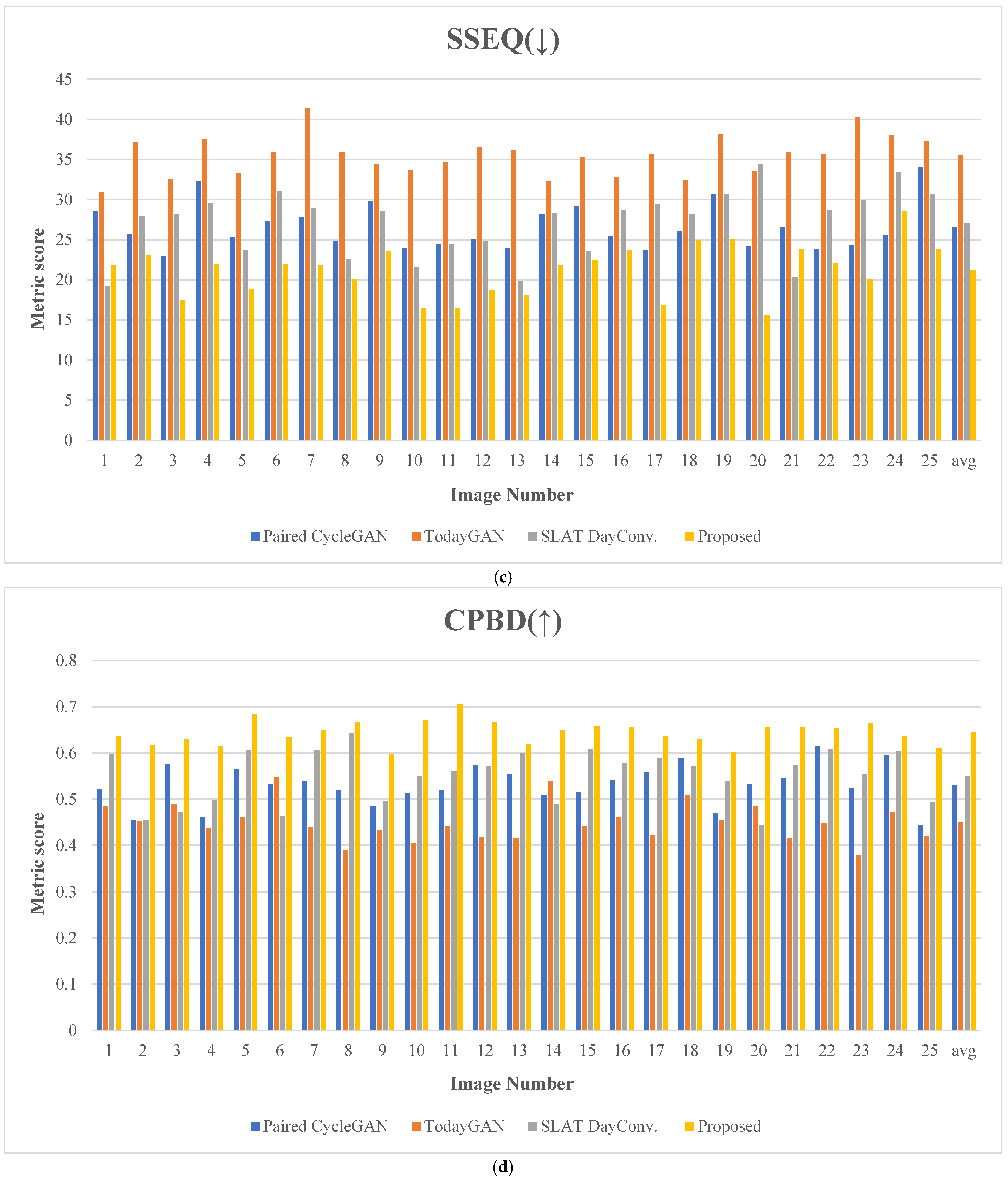
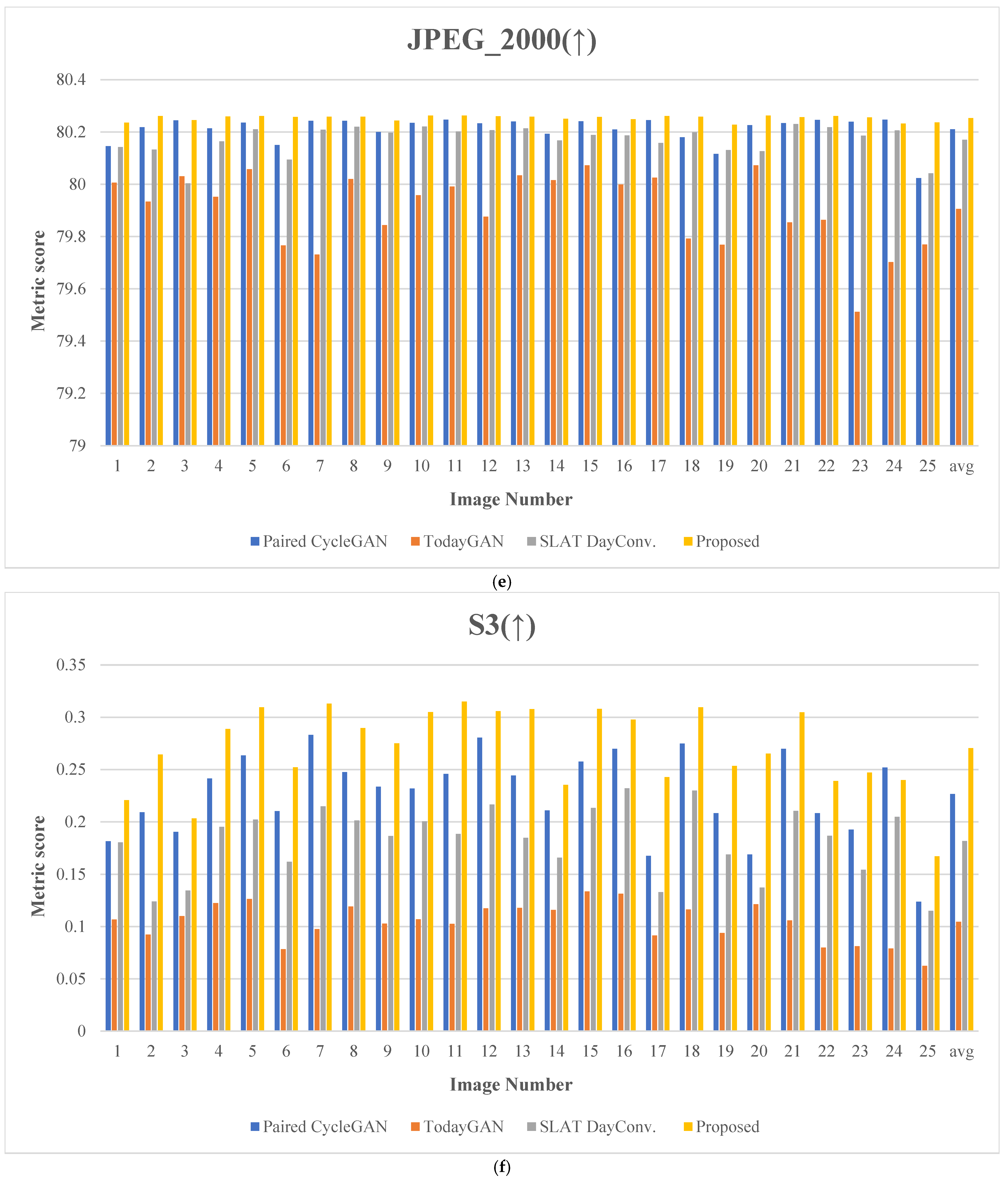
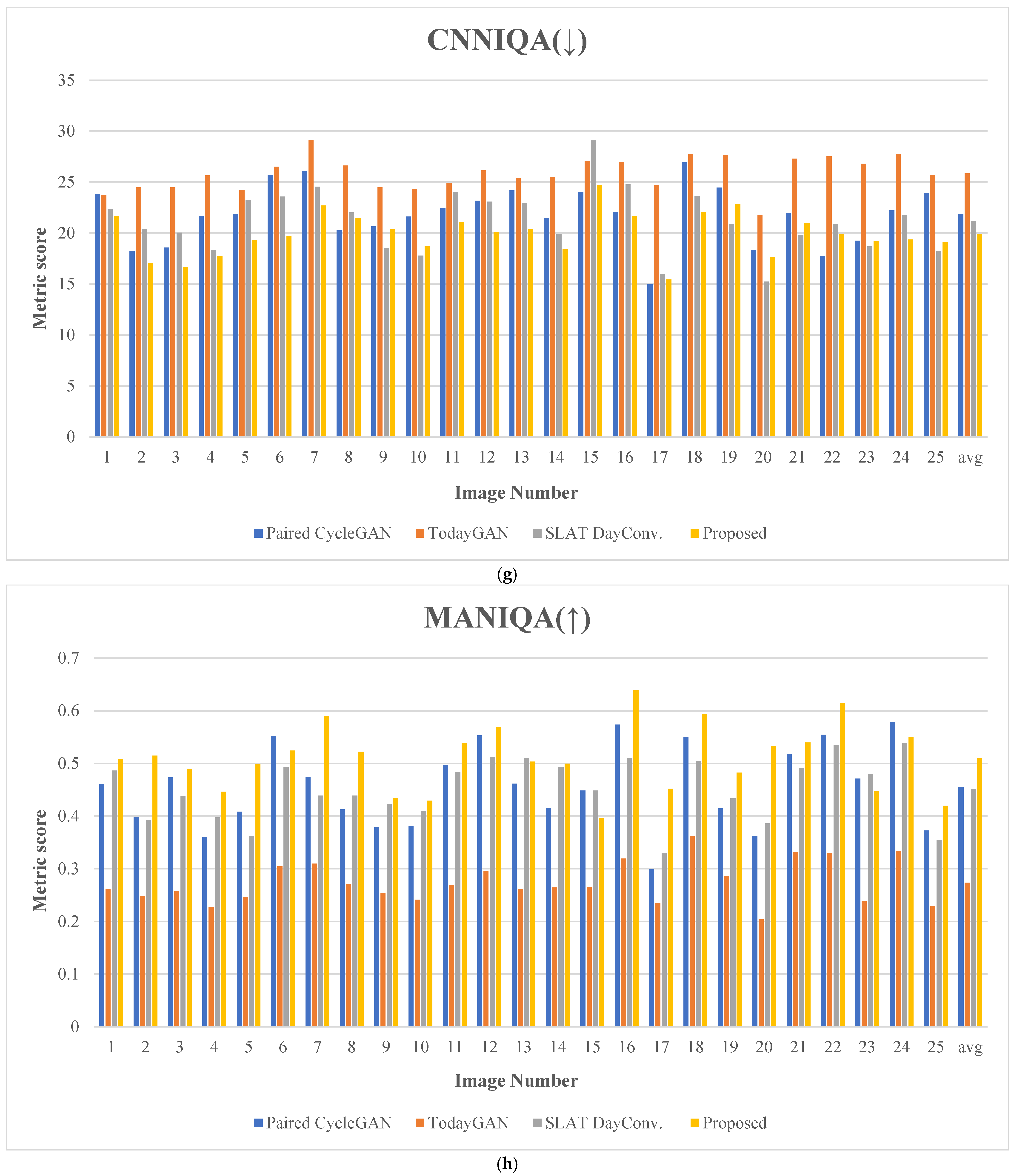

| Name | Components of Each Stage |
|---|---|
| Case 1 | Denoising Diffusion Probabilistic Models (DDPMs) |
| Case 2 | 3-channel paired module |
| Case 3 | 4-channel paired module |
| Case 4 | = 0.5 |
| Case 5 | = 2 |
| Paired CycleGAN | TodayGAN | SLAT DayConv. | Proposed | |
|---|---|---|---|---|
| BRISQUE (↓) | 30.468 | 31.880 | 27.713 | 19.350 |
| PIQE (↓) | 42.705 | 58.276 | 45.001 | 34.999 |
| SSEQ (↓) | 26.565 | 35.499 | 27.075 | 21.183 |
| CPBD (↑) | 0.530 | 0.450 | 0.551 | 0.644 |
| JPEG_2000 (↑) | 80.210 | 79.906 | 80.170 | 80.253 |
| S3 (↑) | 0.227 | 0.104 | 0.182 | 0.270 |
| CNNIQA (↓) | 21.835 | 25.870 | 21.195 | 19.935 |
| MANIQA (↑) | 0.455 | 0.274 | 0.451 | 0.509 |
| Paired CycleGAN | TodayGAN | SLAT DayConv. | Proposed | |
|---|---|---|---|---|
| Process time (s) | 10.55 | 9.21 | 13.19 | 10.21 |
| GFLOPs (GFLOPs) | 282.81 | 56.53 | 94.27 | 188.95 |
Disclaimer/Publisher’s Note: The statements, opinions and data contained in all publications are solely those of the individual author(s) and contributor(s) and not of MDPI and/or the editor(s). MDPI and/or the editor(s) disclaim responsibility for any injury to people or property resulting from any ideas, methods, instructions or products referred to in the content. |
© 2025 by the authors. Licensee MDPI, Basel, Switzerland. This article is an open access article distributed under the terms and conditions of the Creative Commons Attribution (CC BY) license (https://creativecommons.org/licenses/by/4.0/).
Share and Cite
Lee, Y.-J.; Go, Y.-H.; Lee, S.-H.; Son, D.-M.; Lee, S.-H. Night-to-Day Image Translation with Road Light Attention Training for Traffic Information Detection. Mathematics 2025, 13, 2998. https://doi.org/10.3390/math13182998
Lee Y-J, Go Y-H, Lee S-H, Son D-M, Lee S-H. Night-to-Day Image Translation with Road Light Attention Training for Traffic Information Detection. Mathematics. 2025; 13(18):2998. https://doi.org/10.3390/math13182998
Chicago/Turabian StyleLee, Ye-Jin, Young-Ho Go, Seung-Hwan Lee, Dong-Min Son, and Sung-Hak Lee. 2025. "Night-to-Day Image Translation with Road Light Attention Training for Traffic Information Detection" Mathematics 13, no. 18: 2998. https://doi.org/10.3390/math13182998
APA StyleLee, Y.-J., Go, Y.-H., Lee, S.-H., Son, D.-M., & Lee, S.-H. (2025). Night-to-Day Image Translation with Road Light Attention Training for Traffic Information Detection. Mathematics, 13(18), 2998. https://doi.org/10.3390/math13182998







